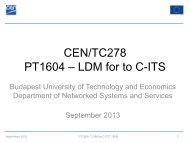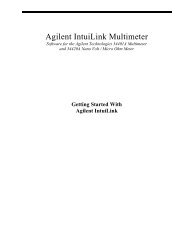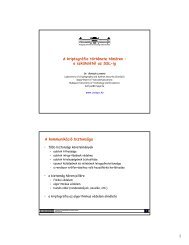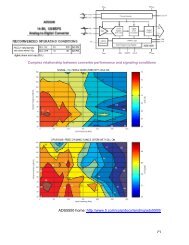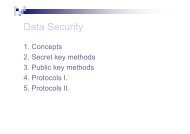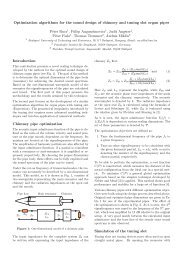HP 33120A User's Guide
HP 33120A User's Guide
HP 33120A User's Guide
Create successful ePaper yourself
Turn your PDF publications into a flip-book with our unique Google optimized e-Paper software.
Chapter 7 Tutorial<br />
Creating Arbitrary Waveforms<br />
Creating Arbitrary Waveforms<br />
For most applications, it is not necessary to create a waveform of any<br />
specific length since the function generator will automatically sample<br />
the available data to produce an output signal. In fact, it is generally<br />
best to create arbitrary waveforms which use all available data<br />
(16,000 points long and the full range from 0 to 4,095 DAC codes). For the<br />
<strong>HP</strong> <strong>33120A</strong>, you do not have to change the length of the waveform to<br />
change its output frequency. All you have to do is create a waveform of<br />
any length and then adjust the function generator’s output frequency.<br />
Remember, if you create an arbitrary waveform that includes three<br />
cycles of a waveshape (for example), the output frequency will be three<br />
times the value displayed on the function generator’s front panel.<br />
When creating arbitrary waveforms, you have control of both the<br />
amplitude quantization and phase truncation errors. For example,<br />
phase truncation harmonics will be generated when a waveform is<br />
created using the full amplitude range of the DAC (12 bits) but is<br />
created using only 1,000 waveform data points. In this case, the<br />
amplitude quantization errors will be near the noise floor while the time<br />
quantization error will produce harmonics near the -60 dBc level.<br />
Similarly, amplitude quantization harmonics will be generated when<br />
you create a waveform using less than the full amplitude resolution of<br />
the function generator. For example, if you use only one-fifth of the<br />
available amplitude resolution, amplitude quantization will produce<br />
harmonics below the -60 dBc level.<br />
When importing data from instruments such as oscilloscopes, the data<br />
will generally range between 1,024 and 4,096 time points and between<br />
64 and 256 amplitude points.<br />
When creating arbitrary waveforms, the function generator will always<br />
attempt to replicate the finite-length time record to produce a periodic<br />
version of the data in waveform memory. As shown on the next page,<br />
it is possible that the shape and phase of a signal may be such that a<br />
transient is introduced at the end point. When the waveshape is<br />
repeated for all time, this end-point transient will introduce leakage error<br />
in the frequency domain because many spectral terms are required to<br />
describe the discontinuity.<br />
278



